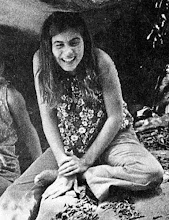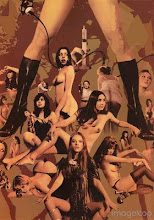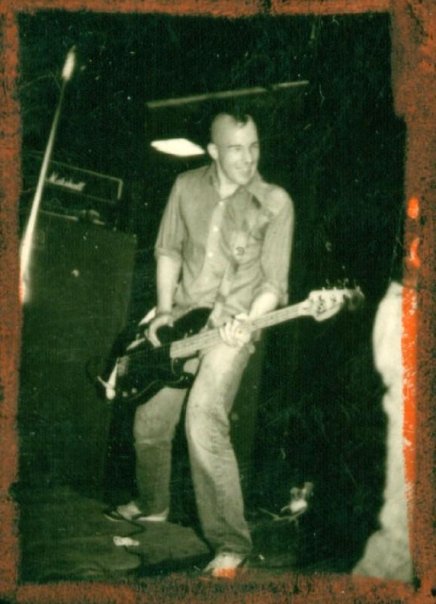Monday, December 29, 2008
Film Review: The Nights of Terror

As soon as Lucio Fulci's "Zombie" hit box office gold around 1980, the low budget Italian cinema industry was plagued with a glut of imitators, cash-ins, and ripoffs. Some, like Umberto Lenzi's "Nightmare City", were fairly original; some, like Joe D'Amato's "Erotic Nights of the Living Dead" and "Porno Holocaust", were little more than pornography disguised as horror; others, like Bruno Mattei's "Hell of the Living Dead" and Marino Girolami's "Zombie Holocaust (Dr. Butcher MD)" were just plain awful. Like the zombies themselves, Italy's directors (save Fulci, who could do no wrong from 1979 to 1982) were blindly stumbling all over the place trying to make sense of a nonsensical genre.
Until 1980, Andrea Bianchi was, like Joe D'Amato, known as a purveyor of fairly well done but sleazy sex films like "Cry of a Prostitute", "Strip Nude for your Killer", "My Father's Wife", and the infamous satanic possession epic "Malabimba" (AKA "The Malicious Whore"). Deciding to jump into the zombie genre, he managed to produce a sublimely excellent film entitled "The Nights of Terror" (AKA "Burial Ground" and "Zombi 3"). One reason this film was so good was because its simplicity (or non-existence) of plot lent it an aura of relentless doom, much like Amando DeOssorio's legendary "Tombs of the Blind Dead" (1971). The story is simple: a bumbling archaeologist disturbs an Etruscan burial tomb near a castle where 3 jet-setting Euro couples (and the son of one of the women) are preparing to spend their vacation. The zombies show up and wreak total havoc, resulting in an apocalypse where all the characters are killed off and the zombies win the day.
A few things set this film apart from other Zombie fare; first, the sexual tension among the couples is extremely intense, and every time the lovers try to go at it the zombies interrupt the coitus with the threat of death. Given the allegedly lusty nature of Etruscan society, it's uncertain whether these zombies want in on the action or are trying to break it up. The film also gained a good deal of controversy over the relationship of the Mother (Mariangela Giordano of "Satan's Baby Doll", "The Sect", and "Gore in Venice") and her son Michael, who is supposed to be 13 or so but is played by "Peter Bark", a totally creepy and unnerving 25 year old dwarf who bears an uncanny resemblance to either a diminutive Dario Argento or Isaac from "Children of the Corn"!. In the middle of the zombie carnage, Mommy comforts Michael, and out of nowhere they start making out, grabassing, and he puts his hand up her dress!! When she rebukes him, he runs away screaming "Why not, I'm your son!". At the end of the film, she confronts the undead son and lets him suckle her breast; naturally he bites it off and proceeds to eat her. Nothing is sacred in this film, not sex, not family, not even religion, for when the surviviors escape the castle and enter a nearby monestary, the monks (cowls and all) proceed to eat the flesh of the living in a hideous reverse sacrament.
The zombies themselves are interesting as well. Not completely mindless, they are able to use simple farming tools as weapons, and even concoct a battering ram to storm the castle. I'm not sure if Bianchi was trying to make a statement on class struggle, but it does seem as if the poor Etruscan zombies are revolting against the elite and decadent partygoers. In one great scene, a maid (the symbol of wealth and privilege) leans out a window and a zombie lifts up a scythe (the global symbol of the reaper) and slices her head off. The zombies below then fight over her head. As in Fulci's zombie films, the makeup effects are done by maestro Gianetto De Rossi, and his zombies are utterly rotten, with maggots all over their faces, and sand for blood. Unlike George A Romero's zombies who look like your next door neighbor only bluer, these things are DEAD. Furthermore, there is a TON of gut-munching in this picture; the entrail budget was probably as high as the actors' salaries, and it's all done very well. One minor complaint: one woman has her head pulled through a window and the glass explicitly slashes her across the eyes, a move blatantly cribbed from both Argento ("Suspiria") and Fulci ("Zombie"'s infamous splinter scene). Still, it's a minor complaint, and an effective set-piece. Also pretty sick is the scene when Mommy goes into a bathroom and sees her now undead girlfriend eating Michaels's severed arm; she then graphically smashes her zombie friend's head to a pulp into the side of the bathtub.
Overall, "The Nights of Terror" stands up as one of the best of the Italian zombie films of the early 80s, mostly because Bianchi, like DeOssorio, Fulci, Romero, and even Jorge Grau ("Living Dead at Manchester Morgue"), realized that the key to good zombie horror lies in infusing the film with an ominous sense of doom and apocalypse, the realization that for the living there is no way out; that death is all that is real.
Boston Crew

1981 to 1984 was the heyday of the Boston Hardcore scene. So many bands and so many shows, so much controversy and so many opinions. As a high school student during that period I was lucky enough to have braved many of those shows, whether it was a Boston band all-ager at a VFW hall or Boston bands opening up for national acts at The Channel. The reputation that the city's punks had was well deserved; there was the constant threat of violence in the air, and sometimes it broke out in big ways. The pit was not a "fun" place to be, and the straight-edge "Boston Crew" was always on the prowl. Sure it was narrow-minded and mostly idiotic, but to my teenage mind it meant something (even if I didn't quite know what).
What is forgotten, however is the MUSIC. Boston HC was different from the other cities. It wasn't snotty and punky like LA, it wasn't anthemic (i.e UK influenced) like DC, and it wasn't arty like SF. It was brutal, it was chaotic, and it was metallic. The Boston bands, more than any other scene, were heavy. As a tribute, here's a list of the cream of the crop, mostly released (vinyl-only at the time) on the Radiobeat, Taang!, and X-Claim labels. Taang! records has fortunately kept much of this material in print and on CD:
Compilations: "Unsafe at any Speed", "This is Boston, not LA"
SS Decontrol: "The Kids will have their Say", "Get it Away"
Jerry's Kids: "Is this my World?"
Gang Green: "Sold Out"
The FUs: "Kill for Christ", "My America"
The Freeze: "Guilty Face", "Land of the Lost"
Kilslug: "Warlocks, Witches, and Demons", "Answer the Call"
Proletariat: "Soma Holiday"
DYS: "Brotherhood"
Negative FX: "Negative FX/Last Rights"
Compilations: "Unsafe at any Speed", "This is Boston, not LA"
SS Decontrol: "The Kids will have their Say", "Get it Away"
Jerry's Kids: "Is this my World?"
Gang Green: "Sold Out"
The FUs: "Kill for Christ", "My America"
The Freeze: "Guilty Face", "Land of the Lost"
Kilslug: "Warlocks, Witches, and Demons", "Answer the Call"
Proletariat: "Soma Holiday"
DYS: "Brotherhood"
Negative FX: "Negative FX/Last Rights"
Wednesday, December 24, 2008
To avoid fainting, keep repeating: "It's only a dream..."

My brother Ross and I were at the pauper's cemetery to visit the grave of our cousin Dave, who died when he was 4 months old. For some reason, the grave marker was only about 4 square inches and the writing was in a language unknown to man. There we met up with our downstairs neighbors the Jonas Brothers and their father, who were also visiting Dave's grave. On the ride home in their limo, Kevin Jonas and I discussed our respective home studios, and I was apalled that he had no idea what any of the equipment was called, nor did he know how to use it. Despite being suspicious of his musical integrity, I still made plans to jam out with him soon.
That night I was at a dinner party being held by Laurie Carlson, a childhood schoolmate who beat me out in the race for Clash tickets in 11th grade. For some reason I was wearing a 3 piece suit and a fraternity pledge pin. Laurie and I hit it off quite well, despite the fact that I was ridiculed by everyone at the party for proclaiming that James Hetfield of Metallica was totally washed up. Laurie came on to me, and we ended up sleeping together, but when I woke up I was in final period of my last day in Brockton High School. When the bell rang and I left the classroom, the school led out onto Newbury Street in Boston.
Suddenly, I was completely naked and wandering the Berkeley School of Music campus looking for my dead father, who was my ride home. When I finally met him, my nude body became covered with soap suds. I told my Dad to wait while I went back into the school to shower off. When I came out, my 3 piece suit was back on, but it was causing me to bob and float above the ground like a Macy's Day Parade balloon. My Dad tried to float as well, saying anyone could do it, but he failed miserably. As I flew higher and higher my father and everything else got smaller and smaller.
Tuesday, December 23, 2008
Welcome!

Welcome to Grim Horror, yet another place to read about film and music by someone who thinks they know more than you! I've been watching horror for 30 years and listening to metal and punk music for about the same time, so I've got lots of opinions to bore you with. I've also been a musician for bands like Afterbirth and Blood Farmers, so expect everything to be darkly humorous. Stay tuned for plenty of reviews, articles, biographies, and twisted musings...
Subscribe to:
Posts (Atom)











